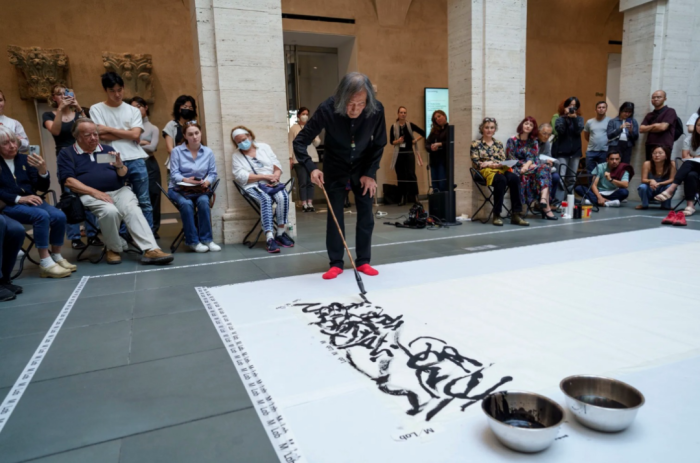

著名当代艺术家、中国美术学院书法学院教授王冬龄于当地时间2024年9月27日在哈佛艺术博物馆考尔德伍德庭院进行了一场书法创作“飞花散雪:王冬龄书苏东坡西湖诗”,并于同期在哈佛大学设计研究生院举办讲座与工作坊。
OnSeptember27,2024,theesteemedcontemporarycalligraphersWangDongling,fromChinaAcademyofArt,presentedanexquisitecalligraphyperformancetitled"FlyingFlowersandScatteredSnow:WangDongling'sCalligraphyofSuDongpo'sWestLakePoems"inCalderwoodCourtyard,HarvardArtMuseums.Duringthesameperiod,Mr.WangdeliveredlecturesandworkshopsatHarvardGraduateSchoolofDesign.

这位身着黑衣、留着齐领灰发的艺术家,在哈佛大学艺术博物馆庭院里聚集的热切观众的注视下,在一张大小如客厅地毯的长方形白纸上,挥洒自如,优美的笔触留下了紧凑、断续的黑色线条和流畅的曲线。
AtfirstitlookedalmostasifWangDonglingwassweepingthefloorwithonehand,usingabrushaboutayardlong.Thegracefulstrokestrailedcompacted,staccatoblacklinesandsweepingcurvesonarectangularwhitesheetthesizeofaliving-roomrug.
Theartist,dressedinblack,hisdarkhaircollar-lengthwithstreaksofgray,hasbeencreatinglarge-scalecalligraphicworksfordecades.OnFriday,infrontofaneagercrowdgatheredinthecourtyardoftheHarvardArtMuseums,hediditagainin“FlyingFlowersandScatteredSnow:WangDongling’sCalligraphyofSuDongpo’sWestLakePoems.”

本次书法创作的主题“飞花散雪:王冬龄书苏东坡西湖诗”,既代表了王冬龄的书法风格,也体现了西湖在中国传统中的文化重要性。
Thetitleofthisperformance,"FlyingFlowersandScatteredSnow:WangDongling'sCalligraphyofSuDongpo'sWestLakePoems,"referstobothMr.Wang'scalligraphicstyleandtheculturalimportanceofWestLakeinChineseliteratitradition.
《春雪》
唐韩愈
新年都未有芳华,二月初惊见草芽。
白雪却嫌春色晚,故穿庭树作飞花。

“飞花散雪”一词源自唐代诗人韩愈的七言诗《春雪》。“飞花”不仅地描绘了雪花纷飞的景象,也暗含了草书流畅而富有动感的线条之美,王冬龄试图通过自己的“乱书”书法来唤起这种飘逸洒脱的风格。此外,宋代诗人、书法家、散文家苏东坡在其诗中勾勒的西湖山水、西湖枯莲等景象也给王冬龄带来深刻启发。在哈佛大学,他重新演绎了苏东坡的西湖诗篇,赋予其新的艺术生命。
Thephrase"flyingflowersandscatteredsnow"comesfromanancientseven-characterpoemwrittenintheTangdynasty(618-907)thatdescribesafluidanddynamiccursivescriptthatMr.Wangtriestoevokethroughhisown"chaoticscript"calligraphy.Mr.WangisalsoinspiredbythewitheredlotusflowersofthefamousWestLakeinHangzhou,theartist'ssecondhometown,whichweredescribedbytheSong-dynasty(960-1279)artist,scholar,andwriterSuDongpo(alsoknownasSuShi,1037-1101)inhispoems.
《饮湖上初晴后雨二首》•其二
宋苏轼
水光潋滟晴方好,山色空蒙雨亦奇。
欲把西湖比西子,淡妆浓抹总相宜。
《六月二十七日望湖楼醉书五首》•其一
宋苏轼
黑云翻墨未遮山,白雨跳珠乱入船。
卷地风来忽吹散,望湖楼下水如天。
《六月二十七日望湖楼醉书五首》•其二
宋苏轼
放生鱼鳖逐人来,无主荷花到处开。
水枕能令山俯仰,风船解与月裴回。

哈佛大学艺术博物馆艾伦·J·德沃斯基中国艺术策展人莎拉·劳森表示,王冬龄运用独创的“乱书”书写“已被抄写数千次的古文”,他的书法风格可以被视为唐代‘狂草’的后继者。同时,他也从抽象表现主义中汲取灵感,选择将文字层层叠加,并将身体动作融入书法创作——这些都是前所未有的组合元素。
Drawnwithcalligraphyinkonpaper,Donglinguseshisownbrandof“chaoticscript”toreproduceancienttexts“thathavebeenwrittendownthousandsoftimesbefore,”SarahLaursen,theAlanJ.DworskyCuratorofChineseArtattheHarvardArtMuseumssaid.
Hisstyle,shesaid,“couldbeseenasadescendantofthe‘wildcursivescript’oftheTangdynasty.However,healsodrawsinspirationfromAbstractExpressionism,choosingtolayerhischaractersontopofeachother,andintegratingphysicalperformanceintohispractice—elementsthathaveneverbeenusedincombinationbefore.”
“他在(杭州)这个城市生活了数十年”,哈佛大学设计学院博士生、协助组织王冬龄此次访问的团队成员之一孙诗宁(ShiningChristinaSun)说到,“他通过这些诗篇,将故乡的体验一路带到了哈佛大学。”
“It’sinthecitywherehehaslivedfordecades,”saidShining(Christina)Sun,adoctoralstudentatHarvard’sGraduateSchoolofDesign.SunispartoftheteamthathelpedorganizeWang’svisitandservedashistranslatoroncampus.“He’sbringingthatexperienceofhishometown,throughthesepoems,allthewaywithhimtoHarvard,”shesaid.

观众在地面、阳台各层聚集,观看这场挥毫泼墨的艺术创作。年近八旬的王冬龄全神贯注于创作之中,笔走龙蛇,挥洒自如——尽管创作过程极具即兴意味,但字体的布局却仿佛早已注定。
OnlookersgatheredonboththegroundandbalconylevelstowatchDonglinginaction.Makingswooping,inkystrokes,thealmost80-year-oldartistgotlostinthework—placingcharactersinawaythatlookedalmostpredetermined,despitetheimprovisationalnatureofhisprocess.

王冬龄创作时非常专注,他可以独自在静谧中创作,也可以在人群簇拥中挥毫,但始终有一种独特气息在不断交织与演绎。在最近比利时皇家美术学院的一场表演中,王冬龄沉浸其中,完全忘却了观众的存在,直到表演结束,人们的掌声响起,他才意识到一直聚焦在他身上的目光。同样的情况也发生在哈佛大学,在近30分钟的创作过程中,观众们全神贯注,直至王冬龄宣布表演结束,他们才忘情地报以热烈的掌声。
“He’sreallyfocusedwhenhedoesit,”Sunsaid.“Hecaneitherdoitinisolatedtranquilityoramongahugecrowd.Butthere’sanatmosphericinterplayalwaysgoingon.”
Dongling,throughSun,recountedarecentperformanceattheBelgianRoyalAcademyofFineArts.Hesaidhetotallyblockedoutthecrowdandforgotanyonewaswatchinguntilpeoplestartedclapping.ThatseemedtohappenwiththeHarvardspectatorsaswell,whowatchedintentlythroughthenearly30-minuteperformance.Politeapplausebrokeoutaftertheartistannouncedhewasfinished.

王冬龄使用VR书写《逍遥游》2021年
WangDongling'sVRCalligraphyCreation,2021
在继承古老艺术传统的同时,王冬龄积极探索书法与现代技术的融合之路。他不仅大胆尝试将虚拟现实技术融入书法创作,还巧妙地运用投影技术,将艺术元素投射,巧妙地在古老与现代之间搭建起桥梁,营造出一种独特的重叠美感。
Anddespitehisclearconnectiontotheancient,Donglinghasbegunexploringcombiningcalligraphywithmoderntechnology.
“HeactuallyhasworkswhereheusesVirtualRealitytocreatea3Dinstallation,”Sunsaid.“HehasdonenotonlyVRbutalsoprojectivetechnologies,whereheprojectedartontopofanotherpieceofwords,likeMatisse.Sohecreatesthatpalimpsestbetweentheancientandcurrent.”
此次演示活动由哈佛艺术博物馆材料实验室联合呈现,旨在旨在搭建桥梁,加深公众与艺术界专业人士之间的沟通与对话。
HostedinconjunctionwiththeHarvardArtMuseumsMaterialsLab,orM/Lab,thedemonstrationwaspartofanefforttofacilitateinteractionsbetweenthepublicandexpertsintheartworld.


哈佛艺术博物馆
HarvardArtMuseums
哈佛艺术博物馆是隶属于哈佛大学的一座综合性艺术博物馆,由福格博物馆、莱辛格博物馆和萨克勒博物馆于2014年合并而成,迁至新馆。该博物馆藏品丰富,涵盖西方油画、雕塑、装饰艺术、亚洲艺术品等多个领域,共计约25万件,并拥有萨第斯考古勘探研究中心等四个专业研究中心,致力于艺术史、考古学及文物保护等方面的研究与教学,为全球艺术爱好者、学者提供了重要的学术平台和文化交流空间。
TheHarvardArtMuseumsisacomprehensiveartmuseumaffiliatedwithHarvardUniversity.Themuseumboastsarichcollectionofapproximately250,000itemsspanningvariousfieldssuchasWesternoilpaintings,sculptures,decorativearts,andAsianartworks.Italsohousesfourspecializedresearchcentersdedicatedtoresearchandteachinginarthistory,archaeology,andculturalheritagepreservation.Itprovidesanimportantacademicplatformandculturalexchangespaceforartloversandscholarsworldwide.

王冬龄,1945年生,江苏如东人。中国美术学院现代书法研究中心主任,中国美术学院教授、博士生导师,杭州市书法家协会终身名誉主席,兰亭书法社社长,西泠印社理事。1981年浙江美术学院(今中国美术学院)首届书法研究生班毕业,文学硕士,留校任教。1989年赴美国明尼苏达大学讲授中国书法四年,为该校及加州大学(圣特鲁斯)客座教授。1994年回中国美术学院执教。
WangDonglingwasborninChina'sJiangsuprovinceandstudiedfineartatNanjingTeacher'sCollege.In1981,hecontinuedhisstudyandbecamethefirstbatchofgraduatesincalligraphyatChinaAcademyofArt.DuringthevibrantAvantGardemovementofthe1980s,Mr.WangbeganexperimentingwithWesternartforms.From1989to1991,hevisitedtheUnitedStatesasaprofessorandbeganexploringabstractionmoredeeply.In1994,hereturnedtoChinaAcademyofArttoresumeteaching.

在六十余年的艺术生涯中,他始终在尺幅、表演性、材料性等多方面摸索实践,探讨中国书法的当代定义。他以其“乱书”书法闻名,将古代文字与传统绘画技法相结合,通过动态表现和抽象手法创作出巨大的笔触作品。作品为中国美术馆、故宫博物院、伦敦大英博物馆、维多利亚和阿尔伯特博物馆,纽约古根海姆美术馆、大都会博物馆、加拿大国家图书馆、温哥华美术馆,以及美国哈佛、耶鲁、斯坦福、伯克利等大学收藏。
AsoneofChina'smosthighlyregardedcontemporarycalligraphers,Mr.Wangisbestknownforhis"chaoticscript"calligraphy.Hecombinesancienttextsandbrushpaintingtraditionswithenergeticperformanceandabstractiontocreateenormousgesturalworks.HehasheldthreesoloexhibitionsattheNationalArtMuseumofChina,andhisworkhasbeenexhibitedandacquiredinternationally.
来源|TheHarvardGazette
翻译|周慧
编辑|倪义臣
责编|周慧
审核|方舟

出品:
中国美术学院党委宣传部
PUBLICITYOFFICEOFTHECPCCAACOMMITTEE
CAA融媒体中心
CAAMEDIACONVERGENCECENTER

